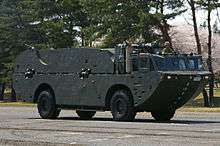Minelayer

Minelaying is the act of deploying explosive mines. Historically this has been carried out by ships, submarines and aircraft. Additionally, since World War I the term minelayer refers specifically to a naval ship used for deploying naval mines.[1] "Mine planting" was the term used for installing controlled mines at predetermined positions in connection with coastal fortifications or harbor approaches that would be detonated by shore control when a ship was fixed as being within the mine's effective range.[2][3]
Before World War I, mine ships were termed mine planters generally. For example, in an address to the United States Navy ships of Mine Squadron One at Portland, England Admiral Sims used the term “mine layer” while the introduction speaks of the men assembled from the “mine planters”.[4] During and after that war the term "mine planter" became particularly associated with defensive coastal fortifications. The term "minelayer" was applied to vessels deploying both defensive- and offensive mine barrages and large scale sea mining. "Minelayer" lasted well past the last common use of "mine planter" in the late 1940s.
An army's special-purpose combat engineering vehicles used to lay landmines are sometimes called "minelayers".
Naval minelayers
.jpg)

The most common use of the term "minelayer" is a naval ship used for deploying sea mines. In the Gallipoli Campaign of World War I, mines laid by the Ottoman Empire's Navy's Nusret sank HMS Irresistible, HMS Ocean, and the French battleship Bouvet[5] in the Dardanelles on 18 March 1915.[6] Russian minelayers were also efficient; sinking the Japanese battleships Hatsuse and Yashima in 1904 in the Russo-Japanese War.[7]
In World War II, the British employed the Abdiel minelayers both as minelayers and as transports to isolated garrisons, such as Malta and Tobruk. Their combination of high speed (up to 40 knots) and carrying capacity was highly valued. The French used the same concept for the cruiser Pluton.
A naval minelayer can vary considerably in size, from coastal boats of several hundred tonnes in displacement to destroyer-like ships of several thousand tonnes displacement. Apart from their loads of sea mines, most would also carry other weapons for self-defense.
Submarines can also be minelayers. The first submarine to be designed as such was the Russian submarine Krab. USS Argonaut (SM-1) was another such minelaying submarine. Although there are no modern submarine minelayers, mines sized to be deployed from a submarine's torpedo tubes, such as the Stonefish, allow any submarine to be a minelayer.
In modern times, few navies worldwide still possess minelaying vessels. The United States Navy, for example, uses aircraft to lay sea mines instead. Mines themselves have evolved from purely passive to active; for example the US CAPTOR (enCAPsulated TORpedo) that sits as a mine until detecting a target upon which a torpedo is launched.
A few navies still have dedicated minelayers in commission, including those of South Korea, Poland, Sweden and Finland; countries with long, shallow coastlines where sea mines are most effective. Other navies have plans to create extemporised minelayers in times of war, for example by rolling sea-mines into the sea from the vehicle deck through the open aft doors of a Roll-on/roll-off ferry. In 1984 the Libyan Navy was suspected of having mined the Red Sea a few nautical miles south of the Suez Canal using the Ro-Ro ferry Ghat, other nations suspected of having similar wartime plans include Iran and North Korea.
Aerial minelaying
Beginning in World War II, military aircraft were used to deliver naval mines by dropping them, attached to a parachute. Germany, Britain and the USA made significant use of aerial minelaying.
A new type of magnetic mine dropped by a German aircraft in a campaign of mining the Thames Estuary in 1939 landed in a mudflat, where disposal experts determined how it worked, which allowed Britain to fashion appropriate mine countermeasures.
The British Royal Air Force minelaying operations were codenamed "Gardening". As well as mining the North Sea and approaches to German ports, mines were laid in the Danube River near Belgrade, Yugoslavia, starting on 8 April 1944, to block the shipments of petroleum products from the refineries at Ploieşti, Romania.[8]
In the Pacific, the US dropped thousands of mines in Japanese home waters, contributing to that country's defeat.
Aerial mining was also used in the Korean and Vietnam Wars. In Vietnam, rivers and coastal waters were extensively mined with a modified bomb called a destructor that proved very successful.
Landmine laying

Some examples of minelaying vehicles:
- Shielder minelaying system
- GMZ family of minelayers, which the 2S4 Tyulpan is based on, using TM-62 series mines
- Minenwerfer Skorpion
- Type 94 Minelayer
- Istrice (M113 variant)
See also
- List of mine warfare vessels of the Second World War
- Mine Planter Service (U.S. Army)
- Minesweeper (ship)
- Submarine mines in United States harbor defense
Notes
- ↑ "minelayer". Definitions from Dictionary.com. Dictionary.com. Retrieved 6 October 2007.
- ↑ Chappel, Gordon. "Submarine Mine Defense of San Francisco Bay". Historic California Posts — Forts Under the Sea. California State Military Museum. Retrieved 23 May 2013.
- ↑ "Principle Armament – Mine Field". FortMiles.org. Retrieved 23 May 2013.
- ↑ All Hands, ed. (1919). "Speech of Admiral W. S. Sims, U. S. Navy". The Northern Barrage, Mine Force, United States Atlantic Fleet, The North Sea, 1918. Annapolis, MD: Naval Institute Press. p. 108.
- ↑ Smith, Gordon. "Naval War in Outline". World War 1 at Sea: French Navy.
- ↑ "Irresistible, Ocean and Bouvet Go Down, Hitting Mines in Strait.". The New York Times. 20 March 1915.
- ↑ Fitzsimons, B (ed.). The Illustrated Encyclopedia of 20th Century Weapons and Warfare. p. 104.
- ↑ Adkins, Paul (1997). Codeword Dictionary. Osceola, WI: Motorbooks International. p. 79.
References
- Hartcup, Guy (1970). The Challenge of War. New York: Taplinger Publishing Company.
- Hartmann, Gregory K (1979). Weapons that Wait: Mine Warfare in the U.S. Navy. Annapolis, MD: Naval Institute Press. ISBN 0-87021-753-4.